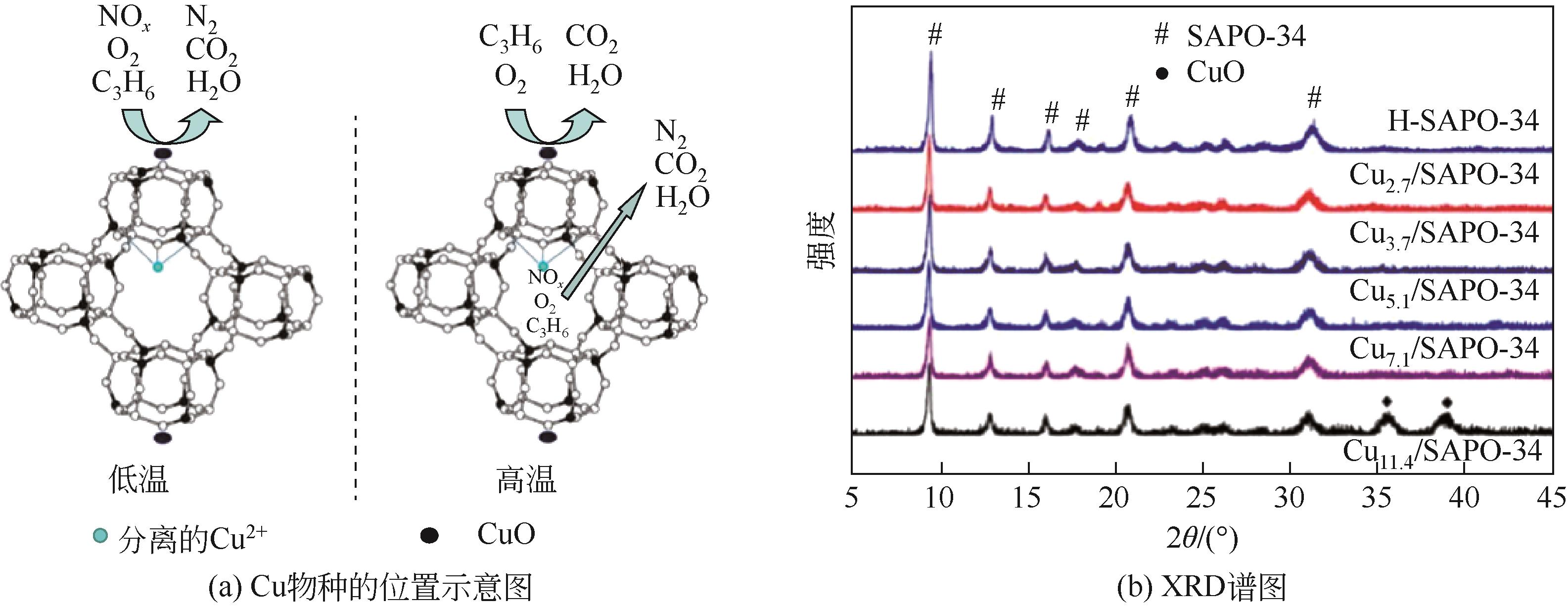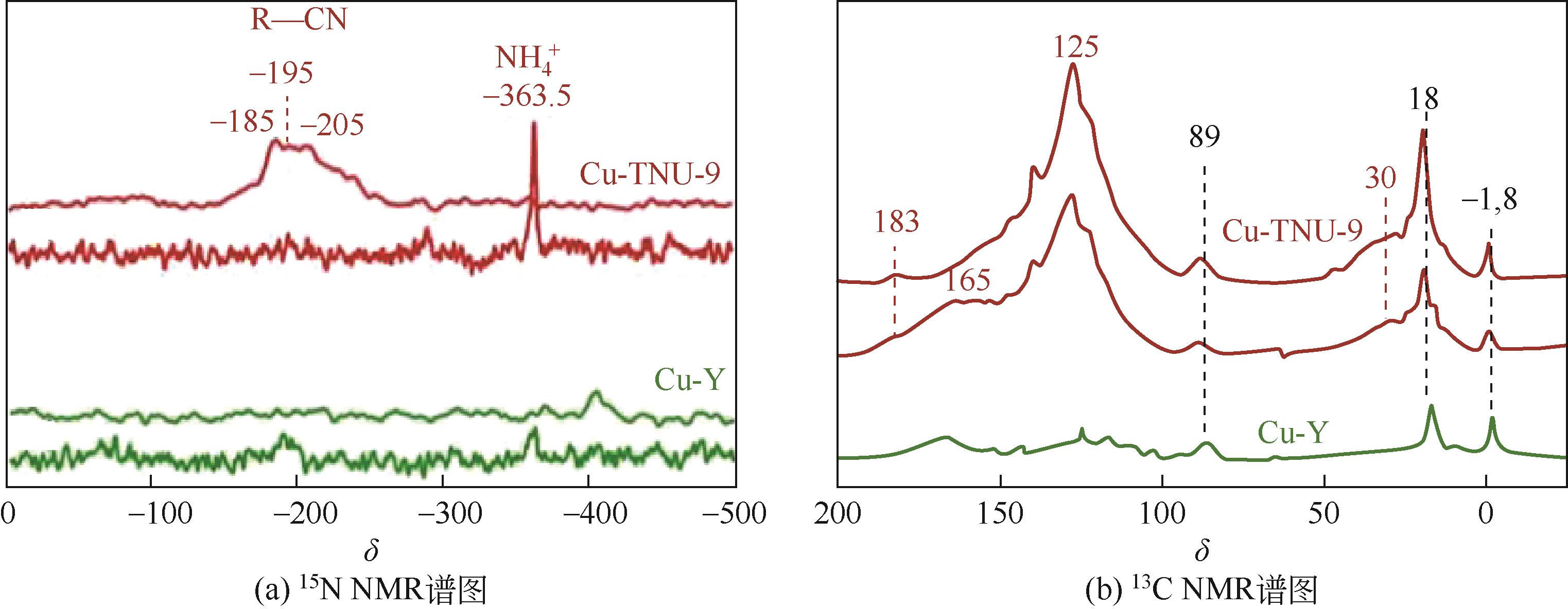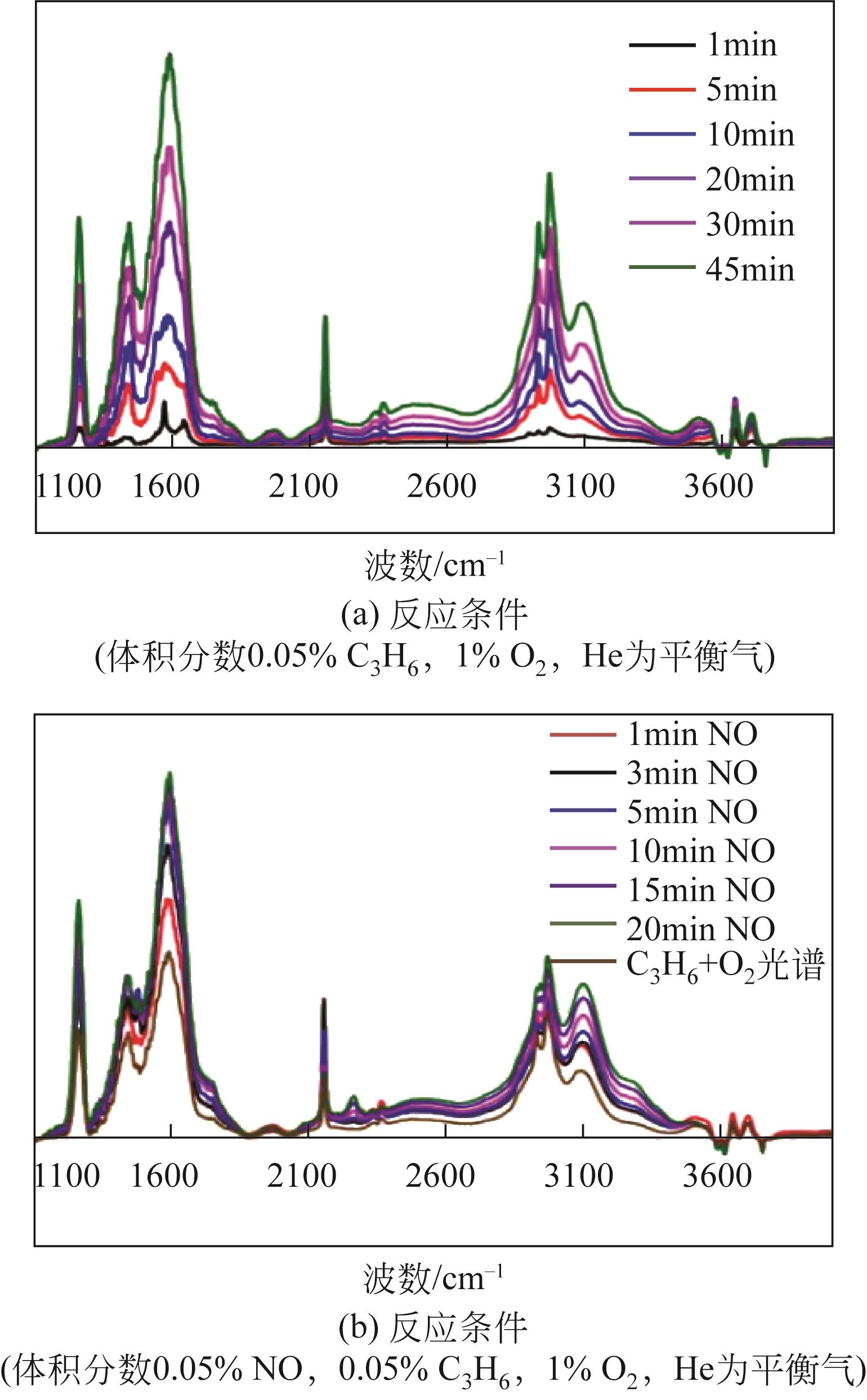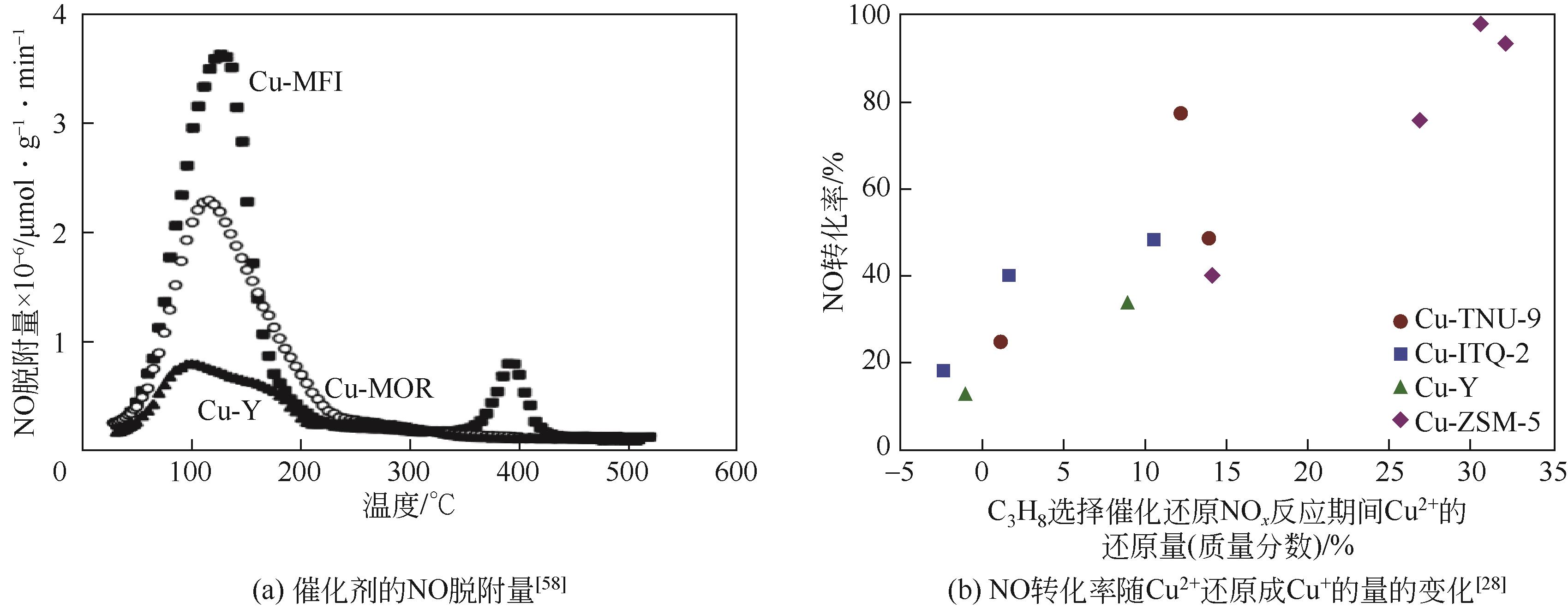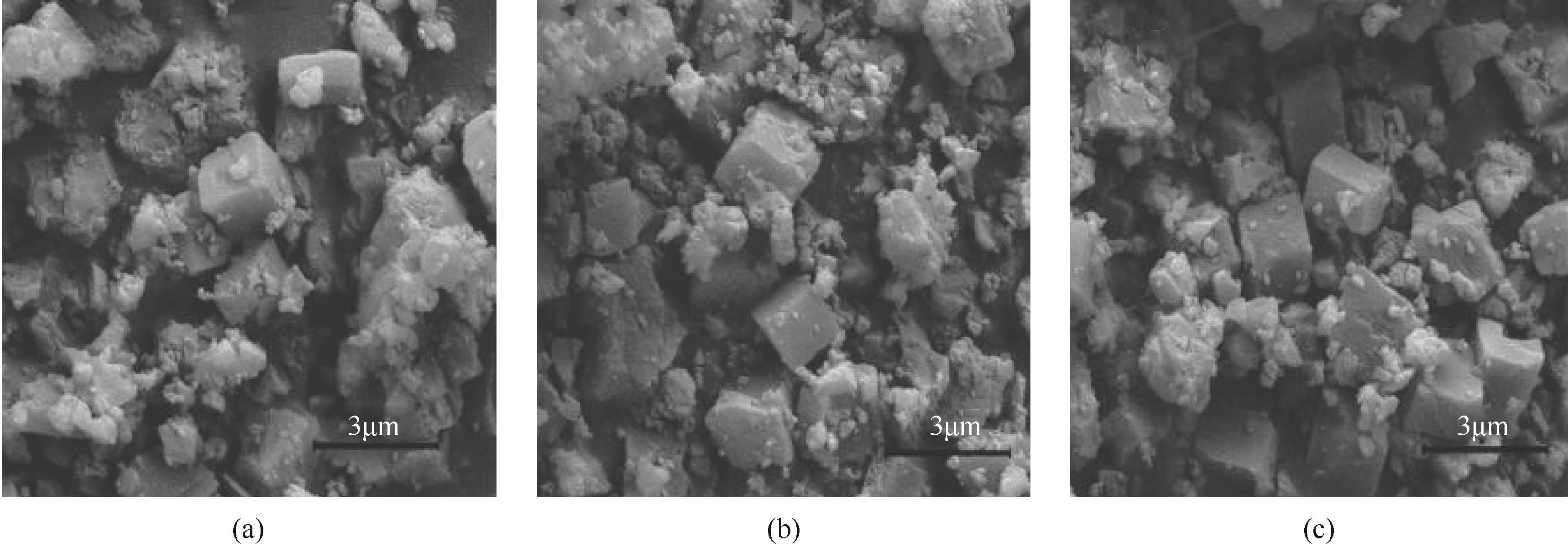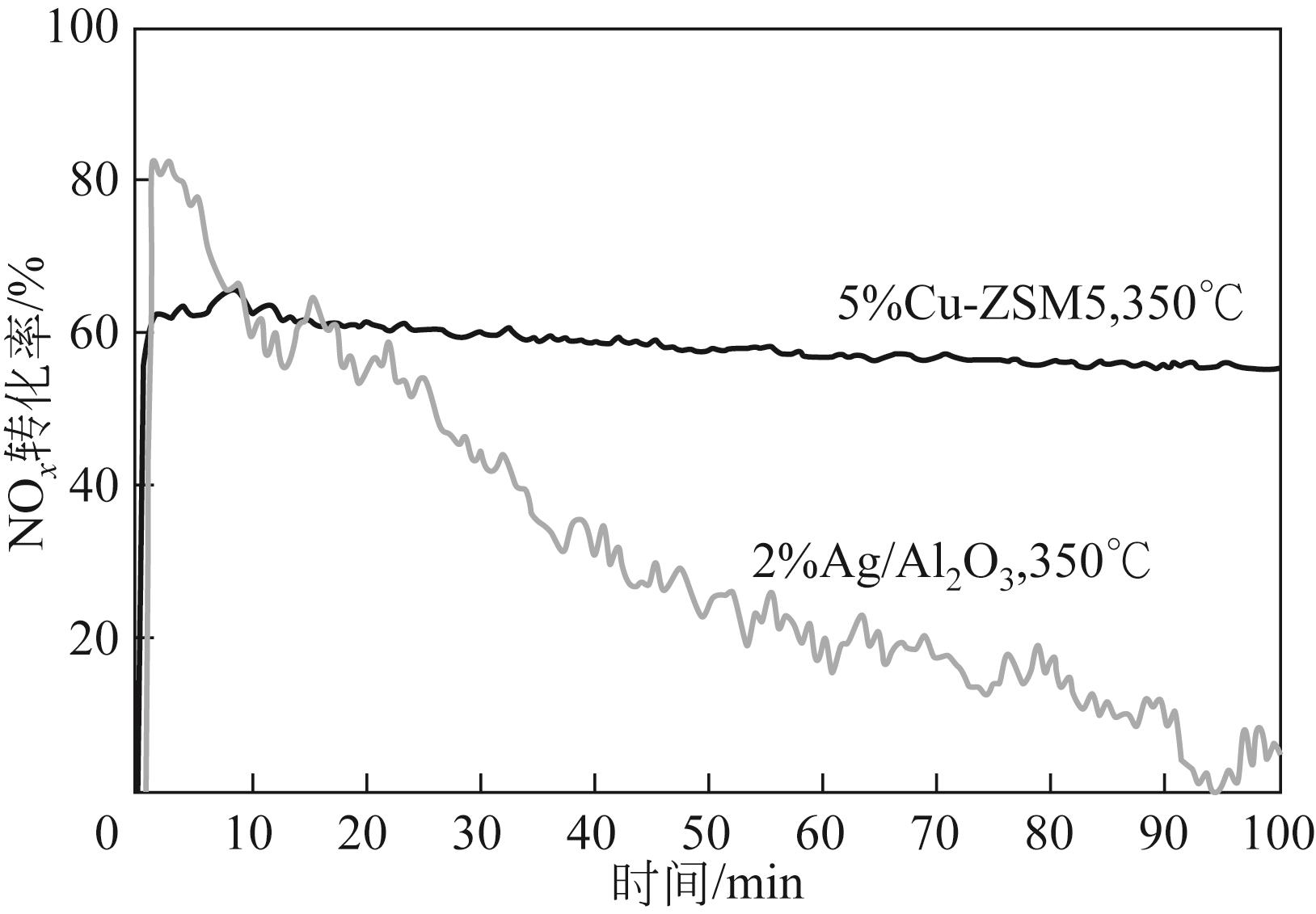化工进展 ›› 2023, Vol. 42 ›› Issue (3): 1308-1320.DOI: 10.16085/j.issn.1000-6613.2022-0931
用于HC-SCR还原NO x 的Cu基分子筛催化剂研究进展
- 东华大学环境科学与工程学院,上海 201620
-
收稿日期:2022-05-19修回日期:2022-08-23出版日期:2023-03-15发布日期:2023-04-10 -
通讯作者:苏亚欣 -
作者简介:宁淑英(1992—),女,博士研究生,研究方向为燃烧污染物控制。E-mail:18366185410@163.com。 -
基金资助:国家自然科学基金(52276103)
Research progress on supported Cu-based zeolite catalysts for the selective catalytic reduction of NO x with hydrocarbons
NING Shuying( ), SU Yaxin(
), SU Yaxin( ), YANG Honghai, WEN Nini
), YANG Honghai, WEN Nini
- College of Environmental Science and Engineering, Donghua University, Shanghai 201620, China
-
Received:2022-05-19Revised:2022-08-23Online:2023-03-15Published:2023-04-10 -
Contact:SU Yaxin
摘要:
烃类化合物选择性催化还原(HC-SCR)是一种有效的脱硝技术,但是在较低温度下Cu基分子筛催化剂用于HC-SCR催化还原NO x 存在催化活性较低、活性温度窗口较窄的问题。本文针对铜/分子筛催化剂选择催化还原NO x 的研究进展,系统介绍了负载型Cu基分子筛催化剂在HC-SCR应用中的反应机理以及载体、负载Cu含量、制备工艺、还原剂、H2O和SO2对催化活性的影响。发现掺杂与铜产生协同作用的金属助剂有助于提高低温催化活性。最后提出了制备具有优异低温催化活性的HC-SCR铜基分子筛催化剂的策略和今后开发高效性能催化剂的研究方向,例如适当增加Cu负载量、控制Si/Al比以及进一步提高金属活性组分的分散性。
中图分类号:
引用本文
宁淑英, 苏亚欣, 杨洪海, 温妮妮. 用于HC-SCR还原NO x 的Cu基分子筛催化剂研究进展[J]. 化工进展, 2023, 42(3): 1308-1320.
NING Shuying, SU Yaxin, YANG Honghai, WEN Nini. Research progress on supported Cu-based zeolite catalysts for the selective catalytic reduction of NO x with hydrocarbons[J]. Chemical Industry and Engineering Progress, 2023, 42(3): 1308-1320.
| 1 | ZHANG Zhiping, LI Yingying, YANG Piaoping, et al. Improved NH3-SCR deNO x activity and tolerance to H2O & SO2 at low temperature over the Nb m Cu0.1- m Ce0.9O x catalysts: role of acidity by niobium doping[J]. Fuel, 2021, 303: 121239. |
| 2 | HALEPOTO A, KASHIF M, SU Y X, et al. Preparations and characterization on Fe based catalyst supported on coconut shell activated carbon CS(AC) and SCR of NO x -HC[J]. Catalysis Surveys from Asia, 2020, 24(2): 123-133. |
| 3 | XU Junqiang, TANG Tian, ZHANG Qiang, et al. Remarkable low temperature catalytic activity for SCR of NO with propylene under oxygen-rich conditions over Mn0.2La0.07Ce0.05O x /ZSM-5 catalyst[J]. Vacuum, 2021, 188: 110174. |
| 4 | SÁNCHEZ-LÓPEZ P, KOTOLEVICH Y, MIRIDONOV S, et al. Bimetallic AgFe systems on mordenite: effect of cation deposition order in the NO reduction with C3H6/CO[J]. Catalysts, 2019, 9(1): 58. |
| 5 | PIETRZYK P, GÓRA-MAREK K, MAZUR T, et al. Structure and mechanistic relevance of Ni2+-NO adduct in model HC SCR reaction over NiZSM-5 catalyst - insights from standard and correlation EPR and IR spectroscopic studies corroborated by molecular modeling[J]. Journal of Catalysis, 2021, 394: 206-219. |
| 6 | LEE K, CHOI B. HC-SCR system combining Ag/Al2O3 and Pd/Al2O3 catalysts with resistance to hydrothermal aging for simultaneous removal of NO, HC, and CO[J]. Journal of Industrial and Engineering Chemistry, 2021, 102: 51-68. |
| 7 | WANG Jie, SHAN Junwei, TIAN Yajie, et al. Catalytic cracking of n-heptane over Fe modified HZSM-5 nanosheet to produce light olefins[J]. Fuel, 2021, 306: 121725. |
| 8 | LEE K, CHOI B, KIM C, et al. De-NO x characteristics of HC-SCR system employing combined Ag/Al2O3 and CuSn/ZSM-5 catalyst[J]. Journal of Industrial and Engineering Chemistry, 2021, 93: 461-475. |
| 9 | 宁汝亮, 刘霄龙, 朱廷钰. 低温SCR脱硝催化剂研究进展[J]. 过程工程学报, 2019, 19(2): 223-234. |
| NING Ruliang, LIU Xiaolong, ZHU Tingyu. Research progress of low-temperature SCR denitration catalysts[J]. The Chinese Journal of Process Engineering, 2019, 19(2): 223-234. | |
| 10 | 赵跃飞, 闫涛涛, 陈凯, 等. Mn掺杂对尖晶石型NiFe1.97Pd0.03O4- δ 催化剂脱硝性能的影响[J]. 化工进展, 2020, 39(2): 577-583. |
| ZHAO Yuefei, YAN Taotao, CHEN Kai, et al. Effect of Mn-doped spinel catalyst NiFe1.97Pd0.03O4- δ on catalytic performance for SCR[J]. Chemical Industry and Engineering Progress, 2020, 39(2): 577-583. | |
| 11 | PRASAD V S, AGHALAYAM P. Microkinetic modeling of HC-SCR of NO to N2, N2O, and NO2 on Pt catalysts in automotive aftertreatment[J]. Industrial & Engineering Chemistry Research, 2017, 56(41): 11705-11712. |
| 12 | LEE K, KOSAKA H, SATO S, et al. Effects of Cu loading and zeolite topology on the selective catalytic reduction with C3H6 over Cu/zeolite catalysts[J]. Journal of Industrial and Engineering Chemistry, 2019, 72: 73-86. |
| 13 | LIU Fang, YANG Li, CHENG Jie, et al. Low temperature deNO x catalytic activity with C2H4 as a reductant using mixed metal Fe-Mn oxides supported on activated carbon[J]. Energies, 2019, 12(22): 4341. |
| 14 | DEKA D J, DAYA R, LADSHAW A, et al. Assessing impact of real-world aging on Cu-redox half cycles of a Cu-SSZ-13 SCR catalyst via transient response measurements and kinetic modeling[J]. Applied Catalysis B: Environmental, 2022, 309: 121233. |
| 15 | WEN Nini, LIN Rui, SU Yaxin, et al. SCR of NO with CH4 over Fe/Ga2O3-Al2O3 and the mechanism[J]. Journal of Environmental Chemical Engineering, 2021, 9(1): 105014. |
| 16 | ŁAMACZ A, KRZTOŃ A, DJÉGA-MARIADASSOU G. Study on the selective catalytic reduction of NO with toluene over CuO/CeZrO2. A confirmation for the three-function model of HC-SCR using the temperature programmed methods and in situ DRIFTS[J]. Applied Catalysis B: Environmental, 2013, 142/143: 268-277. |
| 17 | 周皞, 张恒, 温妮妮, 等. Cu-SAPO-44分子筛的制备及其C3H6-SCR脱硝性能[J]. 化工进展, 2023, 42(3): 1374-1383. |
| ZHOU Hao, ZHANG Heng, WEN Nini,et al. Preparation and de-NO x performance of C3H6-SCR over Cu-SAPO-44 catalyst[J]. Chemical Industry and Engineering Progress, 2023, 42(3): 1374-1383. | |
| 18 | GHOLAMI F, TOMAS M, GHOLAMI Z, et al. Technologies for the nitrogen oxides reduction from flue gas: a review[J]. Science of the Total Environment, 2020, 714: 136712. |
| 19 | YANG Zhi, DONG Anqi, CHEN Haijun. Cu/zeolite catalysts for the photocatalytic decomposition and selective catalytic reduction of NO x [J]. Research on Chemical Intermediates, 2017, 43(9): 5245-5259. |
| 20 | NGUYEN V T, NGUYEN D B, HEO I, et al. Evaluation of low-temperature NO x removal over Ag/ZSM5 and Cu/ZSM5 catalysts coupled with plasma[J]. IEEE Transactions on Plasma Science, 2020, 48(7): 2448-2456. |
| 21 | 胡宜康, 徐斌, 曹智焜, 等. Cu基分子筛催化剂抗中毒性能的研究进展[J]. 应用化工, 2020, 49(1): 171-176. |
| HU Yikang, XU Bin, CAO Zhikun, et al. Research progress on the poisoning resistance properties of Cu-based zeolite catalysts[J]. Applied Chemical Industry, 2020, 49(1): 171-176. | |
| 22 | YAHIRO H, IWAMOTO M. Copper ion-exchanged zeolite catalysts in deNO x reaction[J]. Applied Catalysis A: General, 2001, 222(1/2): 163-181. |
| 23 | CASTELLANOS I, MARIE O. Fe-HFER and Cu-HFER as catalysts for the NO x SCR using acetylene as a reducing agent: reaction mechanism revealed by FT-IR operando study coupled with 15NO isotopic labelling[J]. Applied Catalysis B: Environmental, 2018, 223: 143-153. |
| 24 | TORTORELLI M, CHAKAROVA K, LISI L, et al. Disproportionation of associated Cu2+ sites in Cu-ZSM-5 to Cu+ and Cu3+ and FTIR detection of Cu3+(NO) x (x = 1, 2) species[J]. Journal of Catalysis, 2014, 309: 376-385. |
| 25 | YANG Li, JIA Yuanyuan, CHENG Jie, et al. Deactivation mechanism of activated carbon supported copper oxide SCR catalysts in C2H4 reductant[J]. The Canadian Journal of Chemical Engineering, 2019, 97(10): 2708-2716. |
| 26 | Feng BIN, SONG Chonglin, Gang LYU, et al. Selective catalytic reduction of nitric oxide with ammonia over zirconium-doped copper/ZSM-5 catalysts[J]. Applied Catalysis B: Environmental, 2014, 150/151: 532-543. |
| 27 | KOMVOKIS V G, ILIOPOULOU E F, VASALOS I A, et al. Development of optimized Cu-ZSM-5 deNO x catalytic materials both for HC-SCR applications and as FCC catalytic additives[J]. Applied Catalysis A: General, 2007, 325(2): 345-352. |
| 28 | MORENO-GONZÁLEZ M, PALOMARES A E, CHIESA M, et al. Evidence of a Cu2+-alkane interaction in Cu-zeolite catalysts crucial for the selective catalytic reduction of NO x with hydrocarbons[J]. ACS Catalysis, 2017, 7(5): 3501-3509. |
| 29 | LI Landong, GUAN Naijia. HC-SCR reaction pathways on ion exchanged ZSM-5 catalysts[J]. Microporous and Mesoporous Materials, 2009, 117(1/2): 450-457. |
| 30 | KORHONEN S T, FICKEL D W, LOBO R F, et al. Isolated Cu2+ ions: active sites for selective catalytic reduction of NO[J]. Chemical Communications, 2011, 47(2): 800-802. |
| 31 | FRANCH-MARTÍ C, ALONSO-ESCOBAR C, JORDA J L, et al. TNU-9, a new zeolite for the selective catalytic reduction of NO: an in situ X-ray absorption spectroscopy study[J]. Journal of Catalysis, 2012, 295: 22-30. |
| 32 | ITADANI A, YUMURA T, OHKUBO T, et al. Existence of dual species composed of Cu+ in CuMFI being bridged by C2H2 [J]. Physical Chemistry Chemical Physics, 2010, 12(24): 6455-6465. |
| 33 | NISHIGUCHI H, KIMURA S, ISHIHARA T, et al. Selective reduction of NO x with C3H6 over Cu incorporated into silicoalumino-phosphate (SAPO)[J]. Research on Chemical Intermediates, 1998, 24(4): 391-399. |
| 34 | GAO Zhongnan, ZHAO Dongyue, YANG Yuexi, et al. Influence of copper locations on catalytic properties and activities of Cu/SAPO-34 in C3H6-SCR[J]. Industrial & Engineering Chemistry Research, 2021, 60(19): 6940-6949. |
| 35 | ČAPEK L, NOVOVESKÁ K, SOBALÍK Z, et al. Cu-ZSM-5 zeolite highly active in reduction of NO with decane under water vapor presence: comparison of decane, propane and propene by in situ FTIR[J]. Applied Catalysis B: Environmental, 2005, 60(3/4): 201-210. |
| 36 | SATO S, YU-U Y, YAHIRO H, et al. Cu-ZSM-5 zeolite as highly active catalyst for removal of nitrogen monoxide from emission of diesel engines[J]. Applied Catalysis, 1991, 70(1): L1-L5. |
| 37 | SU Yaxin, WEN Nini, CHENG Jianghao, et al. Experimental study on SCR-C3H6 over Cu-Fe/Al-PILC catalysts: catalytic performance, characterization, and mechanism[J]. Industrial & Engineering Chemistry Research, 2020, 59(33): 14776-14788. |
| 38 | YANG Wei, ZHANG Runduo, CHEN Biaohua, et al. New aspects on the mechanism of C3H6 selective catalytic reduction of NO in the presence of O2 over LaFe1- x (Cu, Pd) x O3- δ perovskites[J]. Environmental Science & Technology, 2012, 46(20): 11280-11288. |
| 39 | XU Junqiang, WANG Honglin, GUO Fang, et al. Recent advances in supported molecular sieve catalysts with wide temperature range for selective catalytic reduction of NO x with C3H6 [J]. RSC Advances, 2019, 9(2): 824-838. |
| 40 | FU Mengfan, LI Caiting, LU Pei, et al. A review on selective catalytic reduction of NO x by supported catalysts at 100~300℃ —catalysts, mechanism, kinetics[J]. Catal. Sci. Technol., 2014, 4(1): 14-25. |
| 41 | MRAD R, AISSAT A, COUSIN R, et al. Catalysts for NO x selective catalytic reduction by hydrocarbons (HC-SCR)[J]. Applied Catalysis A: General, 2015, 504: 542-548. |
| 42 | CANT N W, LIU I O Y. The mechanism of the selective reduction of nitrogen oxides by hydrocarbons on zeolite catalysts[J]. Catalysis Today, 2000, 63(2/3/4): 133-146. |
| 43 | SADYKOV V, LUNIN V, MATYSHAK V, et al. The reaction mechanism of selective catalytic reduction of nitrogen oxides by hydrocarbons in excess oxygen: intermediates, their reactivity, and routes of transformation[J]. Kinetics and Catalysis, 2003, 44(3): 379-400. |
| 44 | LI Landong, ZHANG Fuxiang, GUAN Naijia, et al. Selective catalytic reduction of NO by propane in excess oxygen over IrCu-ZSM-5 catalyst[J]. Catalysis Communications, 2007, 8(3): 583-588. |
| 45 | SCHAY Z, GUCZI L, BECK A, et al. DeNO x reactions on Cu-zeolites: decomposition of NO, N2O and SCR of NO by C3H8 and CH4 on Cu-ZSM-5 and Cu-AlTS-1 catalysts[J]. Catalysis Today, 2002, 75(1/2/3/4): 393-399. |
| 46 | YASHNIK S, ISMAGILOV Z. Cu-substituted ZSM-5 catalyst: controlling of DeNO x reactivity via ion-exchange mode with copper-ammonia solution[J]. Applied Catalysis B: Environmental, 2015, 170/171: 241-254. |
| 47 | RAJ R, HAROLD M P, BALAKOTAIAH V. NO inhibition effects during oxidation of propylene on Cu-chabazite catalyst: a kinetic and mechanistic study[J]. Industrial & Engineering Chemistry Research, 2013, 52(44): 15455-15465. |
| 48 | BURCH R. Knowledge and know-how in emission control for mobile applications[J]. Catalysis Reviews, 2004, 46(3/4): 271-334. |
| 49 | JANG H J, HALL W K, D'ITRI J L. Redox behavior of CuZSM-5 catalysts: FTIR investigations of reactions of adsorbed NO and CO[J]. The Journal of Physical Chemistry, 1996, 100(22): 9416-9420. |
| 50 | HADJIIVANOV K, SAUSSEY J, FREYSZ J L. FT-IR study of NO+O2 co-adsorption on H-ZSM-5: re-assignment of the 2133cm-1 band to NO+ species[J]. Catalysis Letters, 1998, 52: 103-108. |
| 51 | PARK S K, PARK Y K, PARK S E, et al. Comparison of selective catalytic reduction of NO with C3H6 and C3H8 over Cu(II)-ZSM-5 and Co(II)-ZSM-5[J]. Physical Chemistry Chemical Physics, 2000, 2(23): 5500-5509. |
| 52 | IWAMOTO M, YAHIRO H. Novel catalytic decomposition and reduction of NO[J]. Catalysis Today, 1994, 22(1): 5-18. |
| 53 | PALOMARES A E, FRANCH C, CORMA A. Determining the characteristics of a Co-zeolite to be active for the selective catalytic reduction of NO x with hydrocarbons[J]. Catalysis Today, 2011, 176(1): 239-241. |
| 54 | FICKEL D W, D’ADDIO E, LAUTERBACH J A, et al. The ammonia selective catalytic reduction activity of copper-exchanged small-pore zeolites[J]. Applied Catalysis B: Environmental, 2011, 102(3/4): 441-448. |
| 55 | HUN K J, ZHU H Y, LEE J H, et al. Two different cationic positions in Cu-SSZ-13?[J]. Chemical Communications, 2012, 48(39): 4758-4760. |
| 56 | LIU Fudong, YU Yunbo, HE Hong. Environmentally-benign catalysts for the selective catalytic reduction of NO x from diesel engines: structure-activity relationship and reaction mechanism aspects[J]. Chemical Communications, 2014, 50(62): 8445-8463. |
| 57 | ISHIHARA T, KAGAWA M, HADAMA F, et al. Copper ion-exchanged SAPO-34 as a thermostable catalyst for selective reduction of NO with C3H6 [J]. Journal of Catalysis, 1997, 169(1): 93-102. |
| 58 | TORRE-ABREU C, HENRIQUES C, RIBEIRO F R, et al. Selective catalytic reduction of NO on copper-exchanged zeolites: the role of the structure of the zeolite in the nature of copper-active sites[J]. Catalysis Today, 1999, 54(4): 407-418. |
| 59 | HE Donglin, ZHANG Huiping, YAN Ying. Preparation of Cu-ZSM-5 catalysts by chemical vapour deposition for catalytic wet peroxide oxidation of phenol in a fixed bed reactor[J]. Royal Society Open Science, 2018, 5(4): 172364. |
| 60 | TORRE-ABREU C, RIBEIRO M F, HENRIQUES C, et al. Selective catalytic reduction of NO with propene over CuMFI zeolites: dependence on Si/Al ratio and copper loading[J]. Applied Catalysis B: Environmental, 1997, 11(3/4): 383-401. |
| 61 | 周微, 王福烨, 贺宁, 等. Cu/SSZ-13催化剂脱硝活性中心与催化性能构效关系的研究[J]. 化工学报, 2022, 73(2): 672-680. |
| ZHOU Wei, WANG Fuye, HE Ning, et al. Study on the relationship of active centers and catalytic performance of Cu/SSZ-13 for NH3-SCR[J]. CIESC Journal, 2022, 73(2): 672-680. | |
| 62 | CHENG Jin, HAN Shuai, YE Qing, et al. Selective catalytic reduction of NO with NH3 over the Cu/SAPO-34 catalysts derived from different Cu precursors[J]. Microporous and Mesoporous Materials, 2019, 278: 423-434. |
| 63 | 孟鹏通, 范超, 吕文婷, 等. 整体式堇青石负载的Cu-SSZ-13分子筛催化剂的制备及其氨选择性催化还原脱硝性能[J]. 燃料化学学报, 2020, 48(10): 1216-1223. |
| MENG Pengtong, FAN Chao, Wenting LYU, et al. Preparation of monolithic cordierite supported Cu-SSZ-13 catalyst and its performance in the selective catalytic reduction of NO x with NH3 [J]. Journal of Fuel Chemistry and Technology, 2020, 48(10): 1216-1223. | |
| 64 | PEREDA-AYO B, DE LA TORRE U, ROMERO-SÁEZ M, et al. Influence of the washcoat characteristics on NH3-SCR behavior of Cu-zeolite monoliths[J]. Catalysis Today, 2013, 216: 82-89. |
| 65 | DE LA TORRE U, PEREDA-AYO B, GONZÁLEZ-VELASCO J R. Cu-zeolite NH3-SCR catalysts for NO x removal in the combined NSR-SCR technology[J]. Chemical Engineering Journal, 2012, 207/208: 10-17. |
| 66 | JABŁOŃSKA M, GÓRA-MAREK K, GRILC M, et al. Effect of textural properties and presence of co-cation on NH3-SCR activity of Cu-exchanged ZSM-5[J]. Catalysts, 2021, 11(7): 843. |
| 67 | CHENG Jie, ZHENG Dahai, DAI Chengna, et al. Constructing active copper species in Cu-zeolites for coal-gas-SCR and elucidating the synergistic catalytic function of CuO and Cu2+ ion species[J]. Environmental Science: Nano, 2022, 9(7): 2372-2387. |
| 68 | CHEN Peirong, SIMBÖCK J, SCHÖNEBAUM S, et al. Monitoring NH3 storage and conversion in Cu-ZSM-5 and Cu-SAPO-34 catalysts for NH3-SCR by simultaneous impedance and DRIFT spectroscopy[J]. Sensors and Actuators B: Chemical, 2016, 236: 1075-1082. |
| 69 | RUTKOWSKA M, PACIA I, BASĄG S, et al. Catalytic performance of commercial Cu-ZSM-5 zeolite modified by desilication in NH3-SCR and NH3-SCO processes[J]. Microporous and Mesoporous Materials, 2017, 246: 193-206. |
| 70 | GÜNTER T, PESEK J, SCHÄFER K, et al. Cu-SSZ-13 as pre-turbine NO x -removal-catalyst: impact of pressure and catalyst poisons[J]. Applied Catalysis B: Environmental, 2016, 198: 548-557. |
| 71 | LA TORRE U, PEREDA-AYO B, ROMERO-SÁEZ M, et al. Screening of Fe-Cu-zeolites prepared by different methodology for application in NSR-SCR combined DeNO x systems[J]. Topics in Catalysis, 2013, 56(1/2/3/4/5/6/7/8): 215-221. |
| 72 | ZUO Yongquan, HAN Lina, BAO Weiren, et al. Effect of CuSAPO-34 catalyst preparation method on NO x removal from diesel vehicle exhausts[J]. Chinese Journal of Catalysis, 2013, 34(6): 1112-1122. |
| 73 | JODŁOWSKI P J, CHLEBDA D, PIWOWARCZYK E, et al. In situ and operando spectroscopic studies of sonically aided catalysts for biogas exhaust abatement[J]. Journal of Molecular Structure, 2016, 1126: 132-140. |
| 74 | JIN Ruiben, LIU Yue, WU Zhongbiao, et al. Low-temperature selective catalytic reduction of NO with NH3 over MnCe oxides supported on TiO2 and Al2O3: A comparative study[J]. Chemosphere, 2010, 78(9): 1160-1166. |
| 75 | BANG J H, SUSLICK K S. Applications of ultrasound to the synthesis of nanostructured materials[J]. Advanced Materials, 2010, 22(10): 1039-1059. |
| 76 | ANDAÇ Ö, MURAT TELLI Ş, TATLIER M, et al. Effects of ultrasound on the preparation of zeolite A coatings[J]. Microporous and Mesoporous Materials, 2006, 88(1/2/3): 72-76. |
| 77 | JODŁOWSKI P J, CZEKAJ I, STACHURSKA P, et al. Experimental and theoretical studies of sonically prepared Cu-Y, Cu-USY and Cu-ZSM-5 catalysts for SCR deNO x [J]. Catalysts, 2021, 11(7): 824. |
| 78 | LI Landong, CHEN Jixin, ZHANG Shujuan, et al. Selective catalytic reduction of nitrogen oxides from exhaust of lean burn engine over in situ synthesized monolithic Cu-TS-1/cordierite[J]. Catalysis Today, 2004, 90(3/4): 207-213. |
| 79 | DANG T T H, ZUBOWA H L, BENTRUP U, et al. Microwave-assisted synthesis and characterization of Cu-containing AlPO4-5 and SAPO-5[J]. Microporous and Mesoporous Materials, 2009, 123(1/2/3): 209-220. |
| 80 | ZHUKOV Y M, SHELYAPINA M G, ZVEREVA I A, et al. Microwave assisted versus convention Cu2+ exchange in mordenite[J]. Microporous and Mesoporous Materials, 2018, 259: 220-228. |
| 81 | ZHUKOV Y M, EFIMOV A Y, SHELYAPINA M G, et al. Effect of preparation method on the valence state and encirclement of copper exchange ions in mordenites[J]. Microporous and Mesoporous Materials, 2016, 224: 415-419. |
| 82 | GRAMIGNI F, IACOBONE U, NASELLO N D, et al. Review of hydrocarbon poisoning and deactivation effects on Cu-zeolite, Fe-zeolite, and vanadium-based selective catalytic reduction catalysts for NO x removal from lean exhausts[J]. Industrial & Engineering Chemistry Research, 2021, 60(18): 6403-6420. |
| 83 | ZENGEL D, BARTH S, CASAPU M, et al. The impact of pressure and hydrocarbons on NO x abatement over Cu- and Fe-zeolites at pre-turbocharger position[J]. Catalysts, 2021, 11(3): 336. |
| 84 | OTTINGER N, VEELE R, XI Y Z, et al. Conversion of short-chain alkanes by vanadium-based and Cu/zeolite SCR catalysts[J]. SAE International Journal of Engines, 2016, 9(2): 1241-1246. |
| 85 | ZHENG L, CASAPU M, STEHLE M, et al. Selective catalytic reduction of NO x with ammonia and hydrocarbon oxidation over V2O5-MoO3/TiO2 and V2O5-WO3/TiO2 SCR catalysts[J]. Topics in Catalysis, 2019, 62(1/2/3/4): 129-139. |
| 86 | ZHENG L, ZIMINA A, CASAPU M, et al. Hydrocarbon and soot oxidation over cerium and iron doped vanadium SCR catalysts[J]. ChemCatChem, 2020, 12(24): 6272-6284. |
| 87 | LUO J Y, YEZERETS A, HENRY C, et al. Hydrocarbon poisoning of Cu-zeolite SCR catalysts[C]// SAE Technical Paper Series. 400 Commonwealth Drive, Warrendale, PA, United States: SAE International, 2012. |
| 88 | LUO J Y, OH H, HENRY C, et al. Effect of C3H6 on selective catalytic reduction of NO x by NH3 over a Cu/zeolite catalyst: a mechanistic study[J]. Applied Catalysis B: Environmental, 2012, 123/124: 296-305. |
| 89 | SULTANA A, NANBA T, SASAKI M, et al. Selective catalytic reduction of NO x with NH3 over different copper exchanged zeolites in the presence of decane[J]. Catalysis Today, 2011, 164(1): 495-499. |
| 90 | MA Lei, LI Junhua, CHENG Yisun, et al. Propene poisoning on three typical Fe-zeolites for SCR of NO x with NH₃: from mechanism study to coating modified architecture[J]. Environmental Science & Technology, 2012, 46(3): 1747-1754. |
| 91 | YE Q, WANG L F, YANG R T. Activity, propene poisoning resistance and hydrothermal stability of copper exchanged chabazite-like zeolite catalysts for SCR of NO with ammonia in comparison to Cu/ZSM-5[J]. Applied Catalysis A: General, 2012, 427/428: 24-34. |
| 92 | BOUTROS M, ONFROY T, COSTA P DA. Mesostructured or alumina-mesostructured silica SBA-16 as potential support for NO x reduction and ethanol oxidation[J]. Catalysis Letters, 2010, 139(1/2): 50-55. |
| 93 | DZWIGAJ S, JANAS J, GURGUL J, et al. Do Cu(Ⅱ) ions need Al atoms in their environment to make CuSiBEA active in the SCR of NO by ethanol or propane? A spectroscopy and catalysis study[J]. Applied Catalysis B: Environmental, 2009, 85(3/4): 131-138. |
| 94 | ILIOPOULOU E F, EVDOU A P, LEMONIDOU A A, et al. Ag/alumina catalysts for the selective catalytic reduction of NO x using various reductants[J]. Applied Catalysis A: General, 2004, 274(1/2): 179-189. |
| 95 | BOUTROS M, GÁLVEZ M E, ONFROY T, et al. Influence of synthesis parameters of SBA-15 supported palladium catalysts for methane combustion and simultaneous NO x reduction[J]. Microporous and Mesoporous Materials, 2014, 183: 1-8. |
| 96 | RODRIGUES A, COSTA P DA, MÉTHIVIER C, et al. Controlled preparation of CoPdSiBEA zeolite catalysts for selective catalytic reduction of NO with methane and their characterisation by XRD, DR UV-vis, TPR, XPS[J]. Catalysis Today, 2011, 176(1): 72-76. |
| 97 | SEYEDEYN-AZAD F, ZHANG D K. Selective catalytic reduction of nitric oxide over Cu and Co ion-exchanged ZSM-5 zeolite: the effect of SiO2/Al2O3 ratio and cation loading[J]. Catalysis Today, 2001, 68(1/2/3): 161-171. |
| 98 | CABALLERO A, MORALES J J, CORDON A M, et al. An in situ XAS study of Cu/ZrO2 catalysts under de-NO x reaction conditions[J]. Journal of Catalysis, 2005, 235(2): 295-301. |
| 99 | ESPINÓS J P, MORALES J, BARRANCO A, et al. Interface effects for Cu, CuO, and Cu2O deposited on SiO2 and ZrO2. XPS determination of the valence state of copper in Cu/SiO2 and Cu/ZrO2 catalysts[J]. The Journal of Physical Chemistry B, 2002, 106(27): 6921-6929. |
| 100 | ANSELL G P, DIWELL A F, GOLUNSKI S E, et al. Mechanism of the lean NO x reaction over Cu/ZSM-5[J]. Applied Catalysis B: Environmental, 1993, 2(1): 81-100. |
| 101 | HOUEL V, JAMES D, MILLINGTON P, et al. A comparison of the activity and deactivation of Ag/Al2O3 and Cu/ZSM-5 for HC-SCR under simulated diesel exhaust emission conditions[J]. Journal of Catalysis, 2005, 230(1): 150-157. |
| 102 | HAN J, WANG A Y, ISAPOUR G, et al. N2O formation during NH3-SCR over different zeolite frameworks: effect of framework structure, copper species, and water[J]. Industrial & Engineering Chemistry Research, 2021, 60(49): 17826-17839. |
| 103 | GUO Mingyu, LIU Qingling, LIU Caixia, et al. Rational design of novel CrZrOx catalysts for efficient low temperature SCR of NO x [J]. Chemical Engineering Journal, 2021, 413: 127554. |
| 104 | 王聪颖, 周皞, 杨迪, 等. 一步水热合成Cu-SSZ-13分子筛选择性催化C3H6还原NO[J]. 无机化学学报, 2021, 37(5): 853-866. |
| WANG Congying, ZHOU Hao, YANG Di, et al. Selective catalytic reduction of NO with C3H6 over one-step hydrothermal synthesized Cu-SSZ-13 catalysts[J]. Chinese Journal of Inorganic Chemistry, 2021, 37(5): 853-866. | |
| 105 | 毛静雯, 徐斌, 胡宜康, 等. Ce金属改性对Cu-SAPO-34催化剂水热稳定性能的影响[J]. 燃料化学学报, 2020, 48(10): 1208-1215. |
| MAO Jingwen, XU Bin, HU Yikang, et al. Effect of Ce metal modification on the hydrothermal stability of Cu-SAPO-34 catalyst[J]. Journal of Fuel Chemistry and Technology, 2020, 48(10): 1208-1215. | |
| 106 | OKADA O, TABATA T, KOKITSU M, et al. Advanced catalyst for NO x reduction using hydrocarbons from lean-burning gas engine[J]. Applied Surface Science, 1997, 121/122: 267-272. |
| 107 | CHAJAR Z, DENTON P, DE BERNARD F B, et al. Influence of silver on the catalytic activity of Cu-ZSM-5 for NO SCR by propane. Effect of the presence of water and hydrothermal agings[J]. Catalysis Letters, 1998, 55(3/4): 217-222. |
| 108 | LEISTNER K, MIHAI O, WIJAYANTI K, et al. Comparison of Cu/BEA, Cu/SSZ-13 and Cu/SAPO-34 for ammonia-SCR reactions[J]. Catalysis Today, 2015, 258: 49-55. |
| 109 | NIU Can, SHI Xiaoyan, LIU Fudong, et al. High hydrothermal stability of Cu-SAPO-34 catalysts for the NH3-SCR of NO x [J]. Chemical Engineering Journal, 2016, 294: 254-263. |
| 110 | BRIEND M, VOMSCHEID R, PELTRE M J, et al. Influence of the choice of the template on the short- and long-term stability of SAPO-34 zeolite[J]. The Journal of Physical Chemistry, 1995, 99(20): 8270-8276. |
| 111 | SON I H, KIM M C, KOH H, et al. On the promotion of Ag/γ-Al2O3 by Cs for the SCR of NO by C3H6 [J]. Catalysis Letters, 2001, 75: 191-197. |
| 112 | BERGMAN S L, DAHLIN S, MESILOV V V, et al. In-situ studies of oxidation/reduction of copper in Cu-CHA SCR catalysts: comparison of fresh and SO 2 - poisoned catalysts[J]. Applied Catalysis B: Environmental, 2020, 269: 118722. |
| 113 | DAHLIN S, LANTTO C, ENGLUND J, et al. Chemical aging of Cu-SSZ-13 SCR catalysts for heavy-duty vehicles - influence of sulfur dioxide[J]. Catalysis Today, 2019, 320: 72-83. |
| 114 | SHAN Yulong, SHI Xiaoyan, YAN Zidi, et al. Deactivation of Cu-SSZ-13 in the presence of SO2 during hydrothermal aging[J]. Catalysis Today, 2019, 320: 84-90. |
| 115 | YUE Yuanyuan, LIU Ben, QIN Peng, et al. One-pot synthesis of FeCu-SSZ-13 zeolite with superior performance in selective catalytic reduction of NO by NH3 from natural aluminosilicates[J]. Chemical Engineering Journal, 2020, 398: 125515. |
| [1] | 李梦圆, 郭凡, 李群生. 聚乙烯醇生产中回收工段第三、第四精馏塔的模拟与优化[J]. 化工进展, 2023, 42(S1): 113-123. |
| [2] | 张瑞杰, 刘志林, 王俊文, 张玮, 韩德求, 李婷, 邹雄. 水冷式复叠制冷系统的在线动态模拟与优化[J]. 化工进展, 2023, 42(S1): 124-132. |
| [3] | 王福安. 300kt/a环氧丙烷工艺反应器降耗减排分析[J]. 化工进展, 2023, 42(S1): 213-218. |
| [4] | 陈匡胤, 李蕊兰, 童杨, 沈建华. 质子交换膜燃料电池气体扩散层结构与设计研究进展[J]. 化工进展, 2023, 42(S1): 246-259. |
| [5] | 张明焱, 刘燕, 张雪婷, 刘亚科, 李从举, 张秀玲. 非贵金属双功能催化剂在锌空气电池研究进展[J]. 化工进展, 2023, 42(S1): 276-286. |
| [6] | 时永兴, 林刚, 孙晓航, 蒋韦庚, 乔大伟, 颜彬航. 二氧化碳加氢制甲醇过程中铜基催化剂活性位点研究进展[J]. 化工进展, 2023, 42(S1): 287-298. |
| [7] | 谢璐垚, 陈崧哲, 王来军, 张平. 用于SO2去极化电解制氢的铂基催化剂[J]. 化工进展, 2023, 42(S1): 299-309. |
| [8] | 杨霞珍, 彭伊凡, 刘化章, 霍超. 熔铁催化剂活性相的调控及其费托反应性能[J]. 化工进展, 2023, 42(S1): 310-318. |
| [9] | 王正坤, 黎四芳. 双子表面活性剂癸炔二醇的绿色合成[J]. 化工进展, 2023, 42(S1): 400-410. |
| [10] | 陈崇明, 陈秋, 宫云茜, 车凯, 郁金星, 孙楠楠. 分子筛基CO2吸附剂研究进展[J]. 化工进展, 2023, 42(S1): 411-419. |
| [11] | 王乐乐, 杨万荣, 姚燕, 刘涛, 何川, 刘逍, 苏胜, 孔凡海, 朱仓海, 向军. SCR脱硝催化剂掺废特性及性能影响[J]. 化工进展, 2023, 42(S1): 489-497. |
| [12] | 邓丽萍, 时好雨, 刘霄龙, 陈瑶姬, 严晶颖. 非贵金属改性钒钛基催化剂NH3-SCR脱硝协同控制VOCs[J]. 化工进展, 2023, 42(S1): 542-548. |
| [13] | 孙玉玉, 蔡鑫磊, 汤吉海, 黄晶晶, 黄益平, 刘杰. 反应精馏合成甲基丙烯酸甲酯工艺优化及节能[J]. 化工进展, 2023, 42(S1): 56-63. |
| [14] | 邵博识, 谭宏博. 锯齿波纹板对挥发性有机物低温脱除过程强化模拟分析[J]. 化工进展, 2023, 42(S1): 84-93. |
| [15] | 李春利, 韩晓光, 刘加朋, 王亚涛, 王晨希, 王洪海, 彭胜. 填料塔液体分布器的研究进展[J]. 化工进展, 2023, 42(9): 4479-4495. |
| 阅读次数 | ||||||
|
全文 |
|
|||||
|
摘要 |
|
|||||
